Leading Change: Analyzing Organizational Drivers and Behaviors
VerifiedAdded on 2020/10/22
|17
|5286
|488
Report
AI Summary
This report delves into the critical aspects of understanding and leading change within organizations, using Tesco as a primary case study. It begins by comparing different organizational examples to highlight the various types of changes and their impact. The report then explores the ways in which external and internal drivers of change affect leadership, team, and individual behaviors, providing a comprehensive analysis of these influences. Furthermore, it examines the measures that organizations can take to minimize the negative impacts of change, offering practical strategies for effective implementation. The report also identifies and discusses the different barriers to change and their influence on leadership decision-making. Finally, it reviews different leadership approaches and styles suitable for navigating organizational change. The report concludes by summarizing the key findings and emphasizing the importance of proactive change management for organizational success.
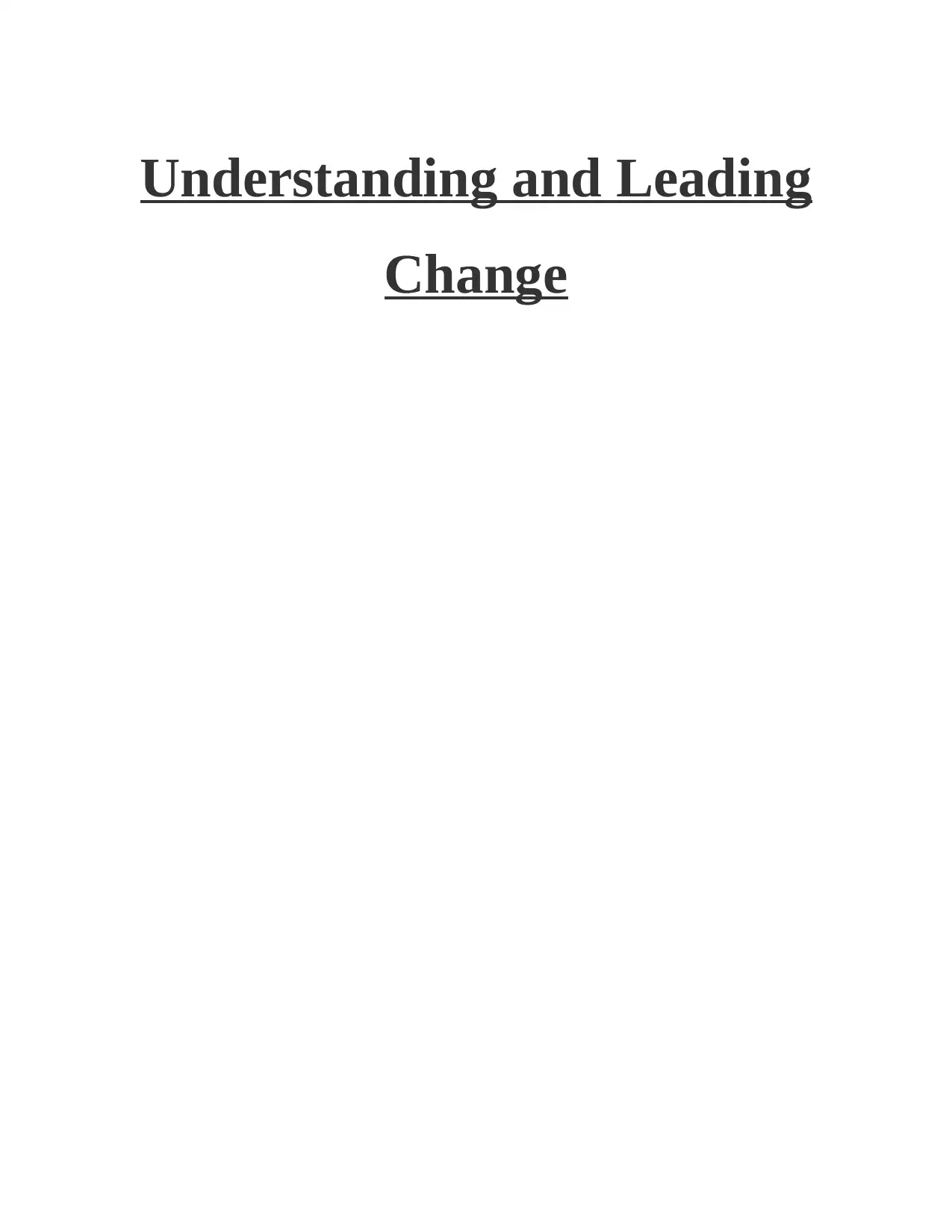
Understanding and Leading
Change
Change
Paraphrase This Document
Need a fresh take? Get an instant paraphrase of this document with our AI Paraphraser
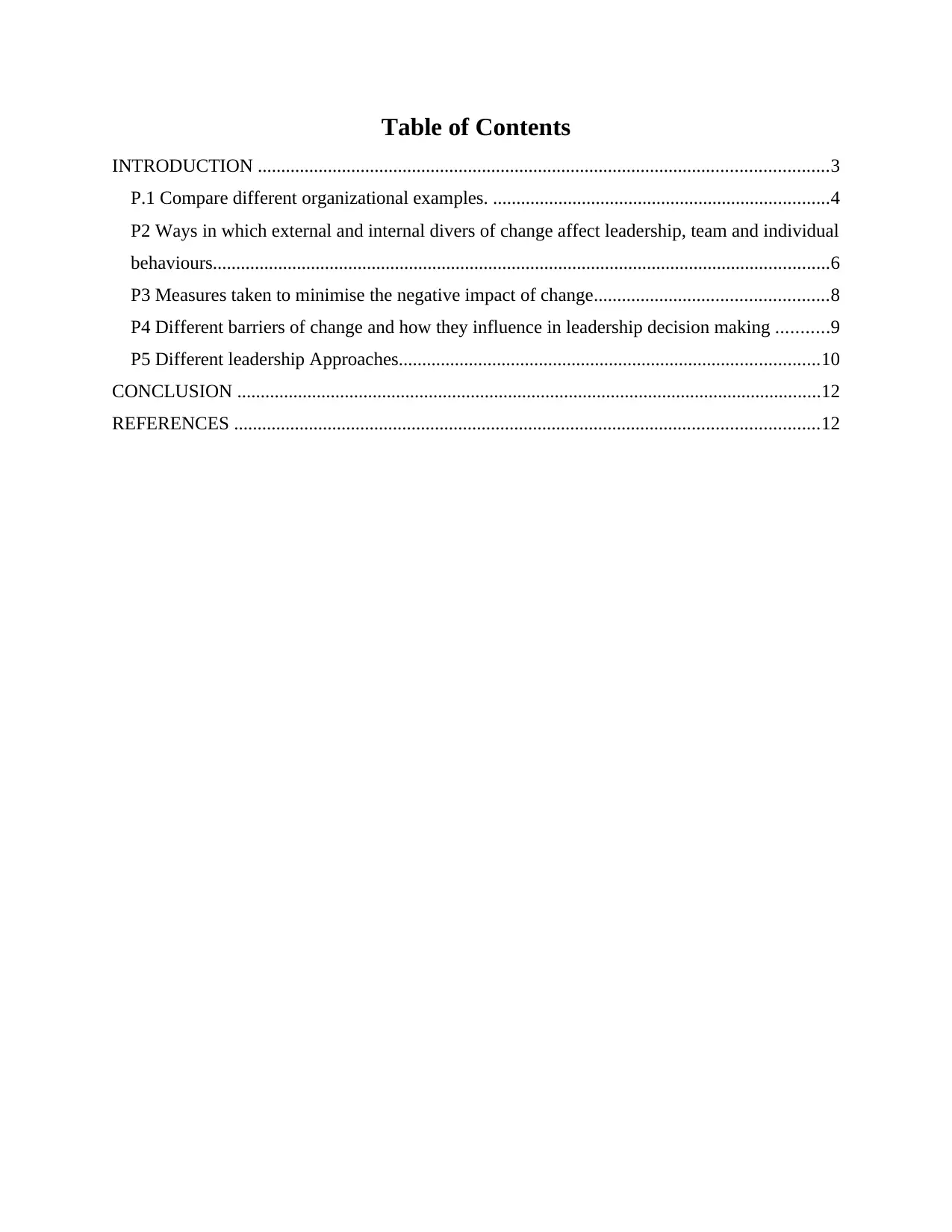
Table of Contents
INTRODUCTION ..........................................................................................................................3
P.1 Compare different organizational examples. ........................................................................4
P2 Ways in which external and internal divers of change affect leadership, team and individual
behaviours....................................................................................................................................6
P3 Measures taken to minimise the negative impact of change..................................................8
P4 Different barriers of change and how they influence in leadership decision making ...........9
P5 Different leadership Approaches..........................................................................................10
CONCLUSION .............................................................................................................................12
REFERENCES .............................................................................................................................12
INTRODUCTION ..........................................................................................................................3
P.1 Compare different organizational examples. ........................................................................4
P2 Ways in which external and internal divers of change affect leadership, team and individual
behaviours....................................................................................................................................6
P3 Measures taken to minimise the negative impact of change..................................................8
P4 Different barriers of change and how they influence in leadership decision making ...........9
P5 Different leadership Approaches..........................................................................................10
CONCLUSION .............................................................................................................................12
REFERENCES .............................................................................................................................12
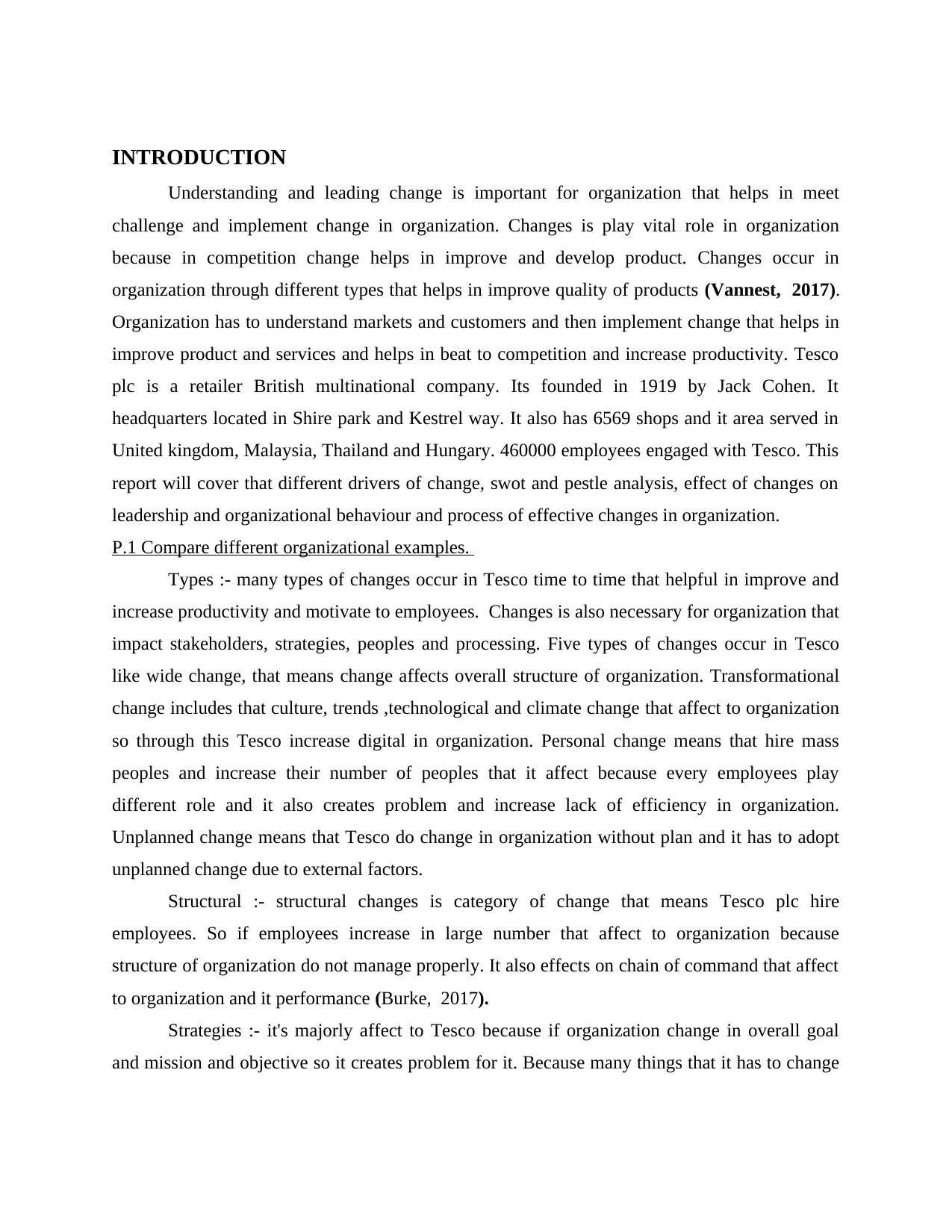
INTRODUCTION
Understanding and leading change is important for organization that helps in meet
challenge and implement change in organization. Changes is play vital role in organization
because in competition change helps in improve and develop product. Changes occur in
organization through different types that helps in improve quality of products (Vannest, 2017).
Organization has to understand markets and customers and then implement change that helps in
improve product and services and helps in beat to competition and increase productivity. Tesco
plc is a retailer British multinational company. Its founded in 1919 by Jack Cohen. It
headquarters located in Shire park and Kestrel way. It also has 6569 shops and it area served in
United kingdom, Malaysia, Thailand and Hungary. 460000 employees engaged with Tesco. This
report will cover that different drivers of change, swot and pestle analysis, effect of changes on
leadership and organizational behaviour and process of effective changes in organization.
P.1 Compare different organizational examples.
Types :- many types of changes occur in Tesco time to time that helpful in improve and
increase productivity and motivate to employees. Changes is also necessary for organization that
impact stakeholders, strategies, peoples and processing. Five types of changes occur in Tesco
like wide change, that means change affects overall structure of organization. Transformational
change includes that culture, trends ,technological and climate change that affect to organization
so through this Tesco increase digital in organization. Personal change means that hire mass
peoples and increase their number of peoples that it affect because every employees play
different role and it also creates problem and increase lack of efficiency in organization.
Unplanned change means that Tesco do change in organization without plan and it has to adopt
unplanned change due to external factors.
Structural :- structural changes is category of change that means Tesco plc hire
employees. So if employees increase in large number that affect to organization because
structure of organization do not manage properly. It also effects on chain of command that affect
to organization and it performance (Burke, 2017).
Strategies :- it's majorly affect to Tesco because if organization change in overall goal
and mission and objective so it creates problem for it. Because many things that it has to change
Understanding and leading change is important for organization that helps in meet
challenge and implement change in organization. Changes is play vital role in organization
because in competition change helps in improve and develop product. Changes occur in
organization through different types that helps in improve quality of products (Vannest, 2017).
Organization has to understand markets and customers and then implement change that helps in
improve product and services and helps in beat to competition and increase productivity. Tesco
plc is a retailer British multinational company. Its founded in 1919 by Jack Cohen. It
headquarters located in Shire park and Kestrel way. It also has 6569 shops and it area served in
United kingdom, Malaysia, Thailand and Hungary. 460000 employees engaged with Tesco. This
report will cover that different drivers of change, swot and pestle analysis, effect of changes on
leadership and organizational behaviour and process of effective changes in organization.
P.1 Compare different organizational examples.
Types :- many types of changes occur in Tesco time to time that helpful in improve and
increase productivity and motivate to employees. Changes is also necessary for organization that
impact stakeholders, strategies, peoples and processing. Five types of changes occur in Tesco
like wide change, that means change affects overall structure of organization. Transformational
change includes that culture, trends ,technological and climate change that affect to organization
so through this Tesco increase digital in organization. Personal change means that hire mass
peoples and increase their number of peoples that it affect because every employees play
different role and it also creates problem and increase lack of efficiency in organization.
Unplanned change means that Tesco do change in organization without plan and it has to adopt
unplanned change due to external factors.
Structural :- structural changes is category of change that means Tesco plc hire
employees. So if employees increase in large number that affect to organization because
structure of organization do not manage properly. It also effects on chain of command that affect
to organization and it performance (Burke, 2017).
Strategies :- it's majorly affect to Tesco because if organization change in overall goal
and mission and objective so it creates problem for it. Because many things that it has to change
⊘ This is a preview!⊘
Do you want full access?
Subscribe today to unlock all pages.

Trusted by 1+ million students worldwide
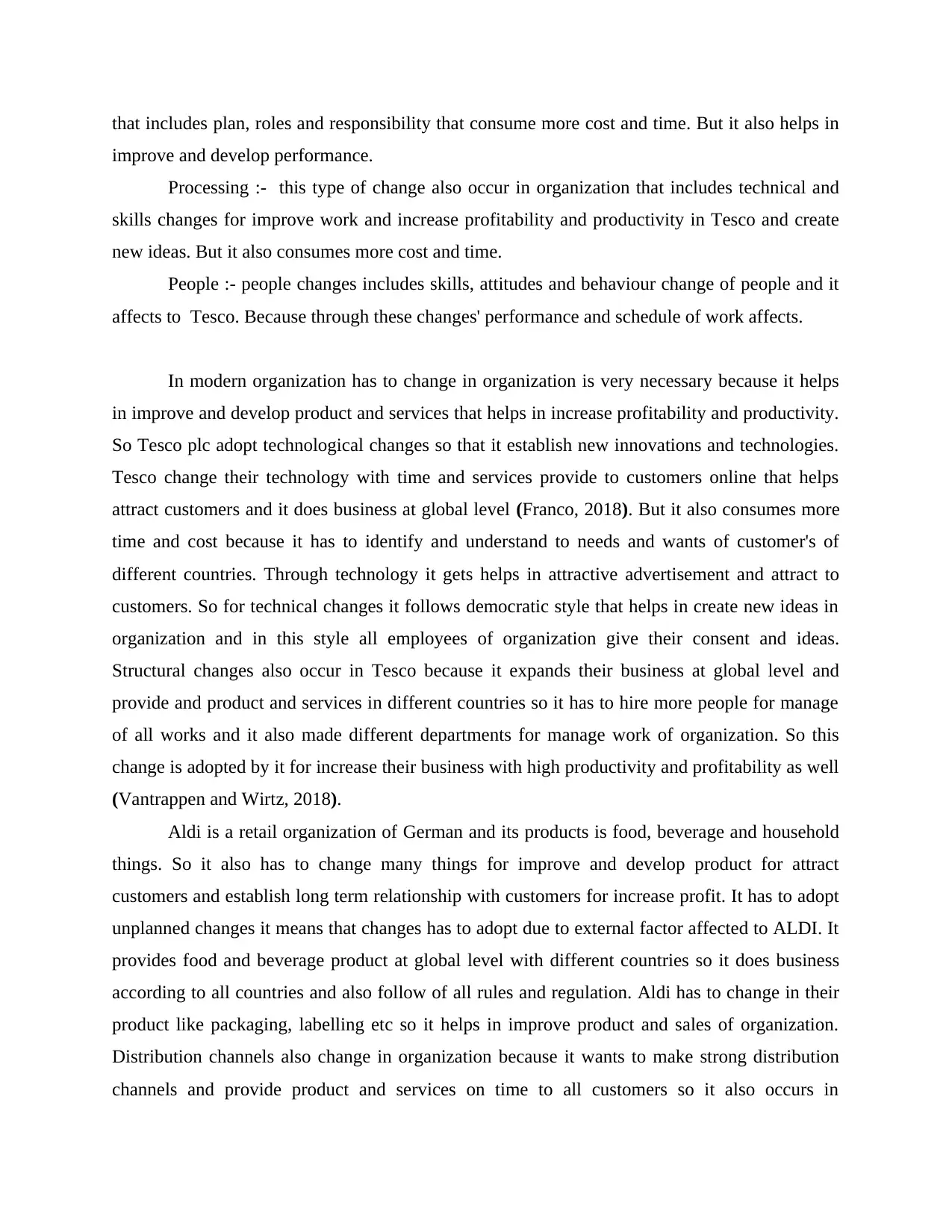
that includes plan, roles and responsibility that consume more cost and time. But it also helps in
improve and develop performance.
Processing :- this type of change also occur in organization that includes technical and
skills changes for improve work and increase profitability and productivity in Tesco and create
new ideas. But it also consumes more cost and time.
People :- people changes includes skills, attitudes and behaviour change of people and it
affects to Tesco. Because through these changes' performance and schedule of work affects.
In modern organization has to change in organization is very necessary because it helps
in improve and develop product and services that helps in increase profitability and productivity.
So Tesco plc adopt technological changes so that it establish new innovations and technologies.
Tesco change their technology with time and services provide to customers online that helps
attract customers and it does business at global level (Franco, 2018). But it also consumes more
time and cost because it has to identify and understand to needs and wants of customer's of
different countries. Through technology it gets helps in attractive advertisement and attract to
customers. So for technical changes it follows democratic style that helps in create new ideas in
organization and in this style all employees of organization give their consent and ideas.
Structural changes also occur in Tesco because it expands their business at global level and
provide and product and services in different countries so it has to hire more people for manage
of all works and it also made different departments for manage work of organization. So this
change is adopted by it for increase their business with high productivity and profitability as well
(Vantrappen and Wirtz, 2018).
Aldi is a retail organization of German and its products is food, beverage and household
things. So it also has to change many things for improve and develop product for attract
customers and establish long term relationship with customers for increase profit. It has to adopt
unplanned changes it means that changes has to adopt due to external factor affected to ALDI. It
provides food and beverage product at global level with different countries so it does business
according to all countries and also follow of all rules and regulation. Aldi has to change in their
product like packaging, labelling etc so it helps in improve product and sales of organization.
Distribution channels also change in organization because it wants to make strong distribution
channels and provide product and services on time to all customers so it also occurs in
improve and develop performance.
Processing :- this type of change also occur in organization that includes technical and
skills changes for improve work and increase profitability and productivity in Tesco and create
new ideas. But it also consumes more cost and time.
People :- people changes includes skills, attitudes and behaviour change of people and it
affects to Tesco. Because through these changes' performance and schedule of work affects.
In modern organization has to change in organization is very necessary because it helps
in improve and develop product and services that helps in increase profitability and productivity.
So Tesco plc adopt technological changes so that it establish new innovations and technologies.
Tesco change their technology with time and services provide to customers online that helps
attract customers and it does business at global level (Franco, 2018). But it also consumes more
time and cost because it has to identify and understand to needs and wants of customer's of
different countries. Through technology it gets helps in attractive advertisement and attract to
customers. So for technical changes it follows democratic style that helps in create new ideas in
organization and in this style all employees of organization give their consent and ideas.
Structural changes also occur in Tesco because it expands their business at global level and
provide and product and services in different countries so it has to hire more people for manage
of all works and it also made different departments for manage work of organization. So this
change is adopted by it for increase their business with high productivity and profitability as well
(Vantrappen and Wirtz, 2018).
Aldi is a retail organization of German and its products is food, beverage and household
things. So it also has to change many things for improve and develop product for attract
customers and establish long term relationship with customers for increase profit. It has to adopt
unplanned changes it means that changes has to adopt due to external factor affected to ALDI. It
provides food and beverage product at global level with different countries so it does business
according to all countries and also follow of all rules and regulation. Aldi has to change in their
product like packaging, labelling etc so it helps in improve product and sales of organization.
Distribution channels also change in organization because it wants to make strong distribution
channels and provide product and services on time to all customers so it also occurs in
Paraphrase This Document
Need a fresh take? Get an instant paraphrase of this document with our AI Paraphraser
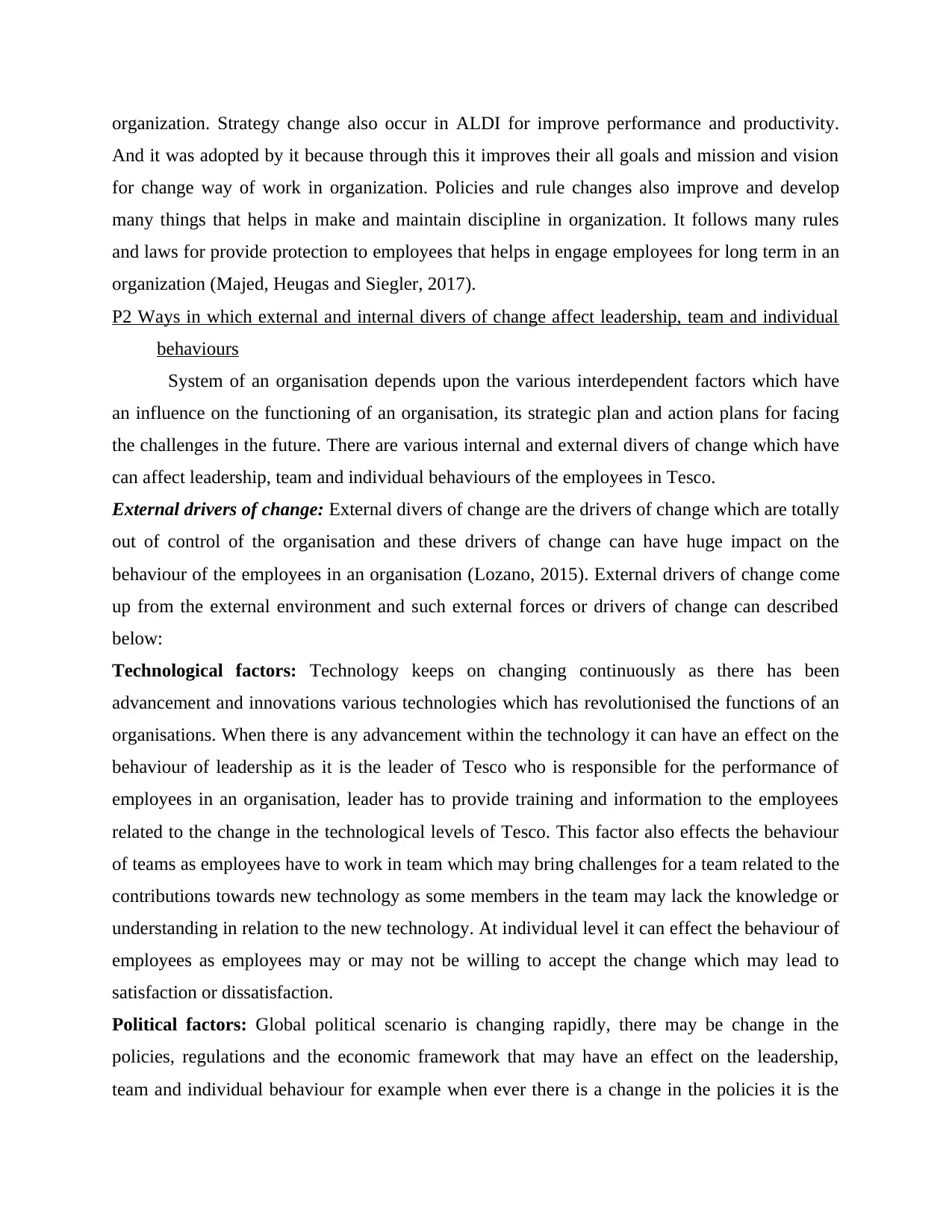
organization. Strategy change also occur in ALDI for improve performance and productivity.
And it was adopted by it because through this it improves their all goals and mission and vision
for change way of work in organization. Policies and rule changes also improve and develop
many things that helps in make and maintain discipline in organization. It follows many rules
and laws for provide protection to employees that helps in engage employees for long term in an
organization (Majed, Heugas and Siegler, 2017).
P2 Ways in which external and internal divers of change affect leadership, team and individual
behaviours
System of an organisation depends upon the various interdependent factors which have
an influence on the functioning of an organisation, its strategic plan and action plans for facing
the challenges in the future. There are various internal and external divers of change which have
can affect leadership, team and individual behaviours of the employees in Tesco.
External drivers of change: External divers of change are the drivers of change which are totally
out of control of the organisation and these drivers of change can have huge impact on the
behaviour of the employees in an organisation (Lozano, 2015). External drivers of change come
up from the external environment and such external forces or drivers of change can described
below:
Technological factors: Technology keeps on changing continuously as there has been
advancement and innovations various technologies which has revolutionised the functions of an
organisations. When there is any advancement within the technology it can have an effect on the
behaviour of leadership as it is the leader of Tesco who is responsible for the performance of
employees in an organisation, leader has to provide training and information to the employees
related to the change in the technological levels of Tesco. This factor also effects the behaviour
of teams as employees have to work in team which may bring challenges for a team related to the
contributions towards new technology as some members in the team may lack the knowledge or
understanding in relation to the new technology. At individual level it can effect the behaviour of
employees as employees may or may not be willing to accept the change which may lead to
satisfaction or dissatisfaction.
Political factors: Global political scenario is changing rapidly, there may be change in the
policies, regulations and the economic framework that may have an effect on the leadership,
team and individual behaviour for example when ever there is a change in the policies it is the
And it was adopted by it because through this it improves their all goals and mission and vision
for change way of work in organization. Policies and rule changes also improve and develop
many things that helps in make and maintain discipline in organization. It follows many rules
and laws for provide protection to employees that helps in engage employees for long term in an
organization (Majed, Heugas and Siegler, 2017).
P2 Ways in which external and internal divers of change affect leadership, team and individual
behaviours
System of an organisation depends upon the various interdependent factors which have
an influence on the functioning of an organisation, its strategic plan and action plans for facing
the challenges in the future. There are various internal and external divers of change which have
can affect leadership, team and individual behaviours of the employees in Tesco.
External drivers of change: External divers of change are the drivers of change which are totally
out of control of the organisation and these drivers of change can have huge impact on the
behaviour of the employees in an organisation (Lozano, 2015). External drivers of change come
up from the external environment and such external forces or drivers of change can described
below:
Technological factors: Technology keeps on changing continuously as there has been
advancement and innovations various technologies which has revolutionised the functions of an
organisations. When there is any advancement within the technology it can have an effect on the
behaviour of leadership as it is the leader of Tesco who is responsible for the performance of
employees in an organisation, leader has to provide training and information to the employees
related to the change in the technological levels of Tesco. This factor also effects the behaviour
of teams as employees have to work in team which may bring challenges for a team related to the
contributions towards new technology as some members in the team may lack the knowledge or
understanding in relation to the new technology. At individual level it can effect the behaviour of
employees as employees may or may not be willing to accept the change which may lead to
satisfaction or dissatisfaction.
Political factors: Global political scenario is changing rapidly, there may be change in the
policies, regulations and the economic framework that may have an effect on the leadership,
team and individual behaviour for example when ever there is a change in the policies it is the
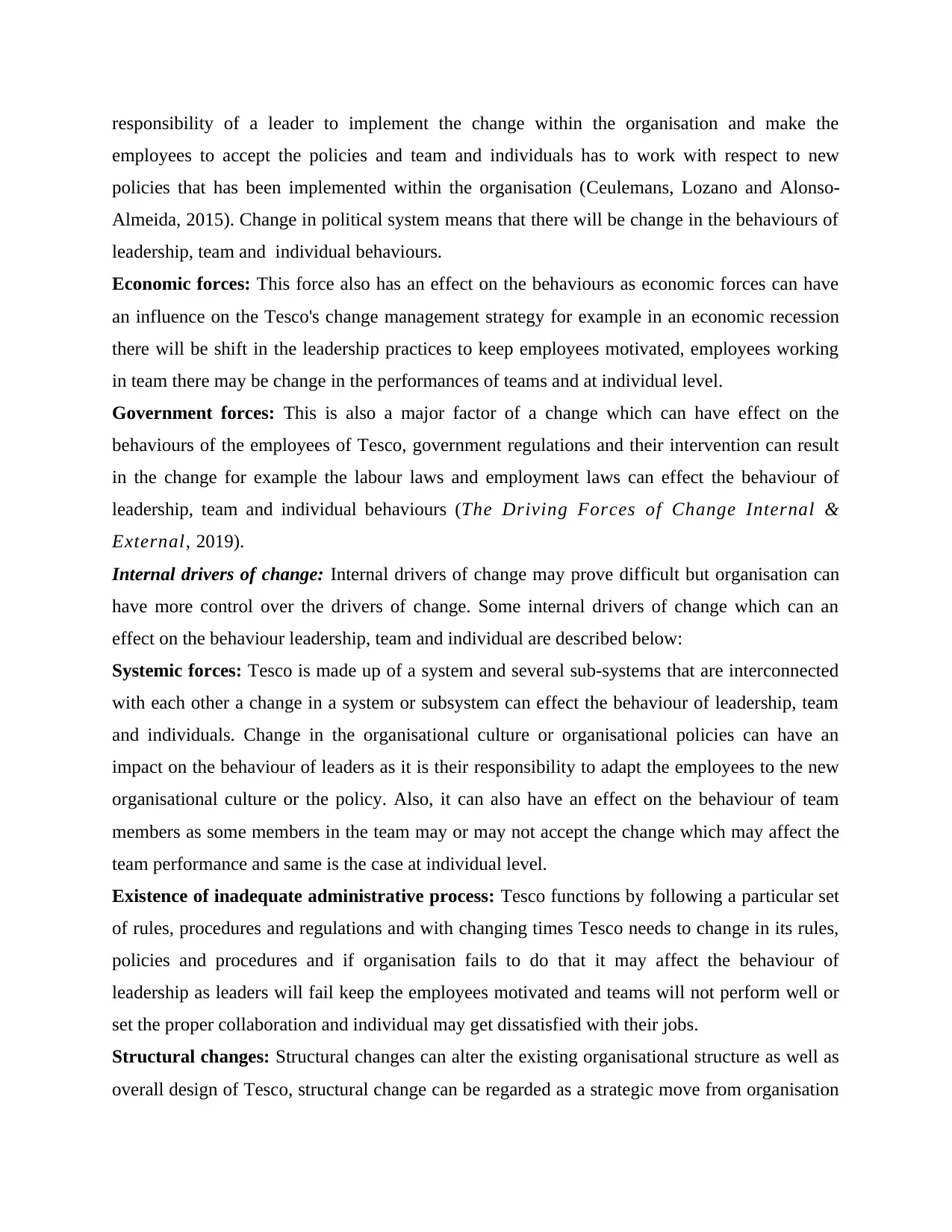
responsibility of a leader to implement the change within the organisation and make the
employees to accept the policies and team and individuals has to work with respect to new
policies that has been implemented within the organisation (Ceulemans, Lozano and Alonso-
Almeida, 2015). Change in political system means that there will be change in the behaviours of
leadership, team and individual behaviours.
Economic forces: This force also has an effect on the behaviours as economic forces can have
an influence on the Tesco's change management strategy for example in an economic recession
there will be shift in the leadership practices to keep employees motivated, employees working
in team there may be change in the performances of teams and at individual level.
Government forces: This is also a major factor of a change which can have effect on the
behaviours of the employees of Tesco, government regulations and their intervention can result
in the change for example the labour laws and employment laws can effect the behaviour of
leadership, team and individual behaviours (The Driving Forces of Change Internal &
External, 2019).
Internal drivers of change: Internal drivers of change may prove difficult but organisation can
have more control over the drivers of change. Some internal drivers of change which can an
effect on the behaviour leadership, team and individual are described below:
Systemic forces: Tesco is made up of a system and several sub-systems that are interconnected
with each other a change in a system or subsystem can effect the behaviour of leadership, team
and individuals. Change in the organisational culture or organisational policies can have an
impact on the behaviour of leaders as it is their responsibility to adapt the employees to the new
organisational culture or the policy. Also, it can also have an effect on the behaviour of team
members as some members in the team may or may not accept the change which may affect the
team performance and same is the case at individual level.
Existence of inadequate administrative process: Tesco functions by following a particular set
of rules, procedures and regulations and with changing times Tesco needs to change in its rules,
policies and procedures and if organisation fails to do that it may affect the behaviour of
leadership as leaders will fail keep the employees motivated and teams will not perform well or
set the proper collaboration and individual may get dissatisfied with their jobs.
Structural changes: Structural changes can alter the existing organisational structure as well as
overall design of Tesco, structural change can be regarded as a strategic move from organisation
employees to accept the policies and team and individuals has to work with respect to new
policies that has been implemented within the organisation (Ceulemans, Lozano and Alonso-
Almeida, 2015). Change in political system means that there will be change in the behaviours of
leadership, team and individual behaviours.
Economic forces: This force also has an effect on the behaviours as economic forces can have
an influence on the Tesco's change management strategy for example in an economic recession
there will be shift in the leadership practices to keep employees motivated, employees working
in team there may be change in the performances of teams and at individual level.
Government forces: This is also a major factor of a change which can have effect on the
behaviours of the employees of Tesco, government regulations and their intervention can result
in the change for example the labour laws and employment laws can effect the behaviour of
leadership, team and individual behaviours (The Driving Forces of Change Internal &
External, 2019).
Internal drivers of change: Internal drivers of change may prove difficult but organisation can
have more control over the drivers of change. Some internal drivers of change which can an
effect on the behaviour leadership, team and individual are described below:
Systemic forces: Tesco is made up of a system and several sub-systems that are interconnected
with each other a change in a system or subsystem can effect the behaviour of leadership, team
and individuals. Change in the organisational culture or organisational policies can have an
impact on the behaviour of leaders as it is their responsibility to adapt the employees to the new
organisational culture or the policy. Also, it can also have an effect on the behaviour of team
members as some members in the team may or may not accept the change which may affect the
team performance and same is the case at individual level.
Existence of inadequate administrative process: Tesco functions by following a particular set
of rules, procedures and regulations and with changing times Tesco needs to change in its rules,
policies and procedures and if organisation fails to do that it may affect the behaviour of
leadership as leaders will fail keep the employees motivated and teams will not perform well or
set the proper collaboration and individual may get dissatisfied with their jobs.
Structural changes: Structural changes can alter the existing organisational structure as well as
overall design of Tesco, structural change can be regarded as a strategic move from organisation
⊘ This is a preview!⊘
Do you want full access?
Subscribe today to unlock all pages.

Trusted by 1+ million students worldwide
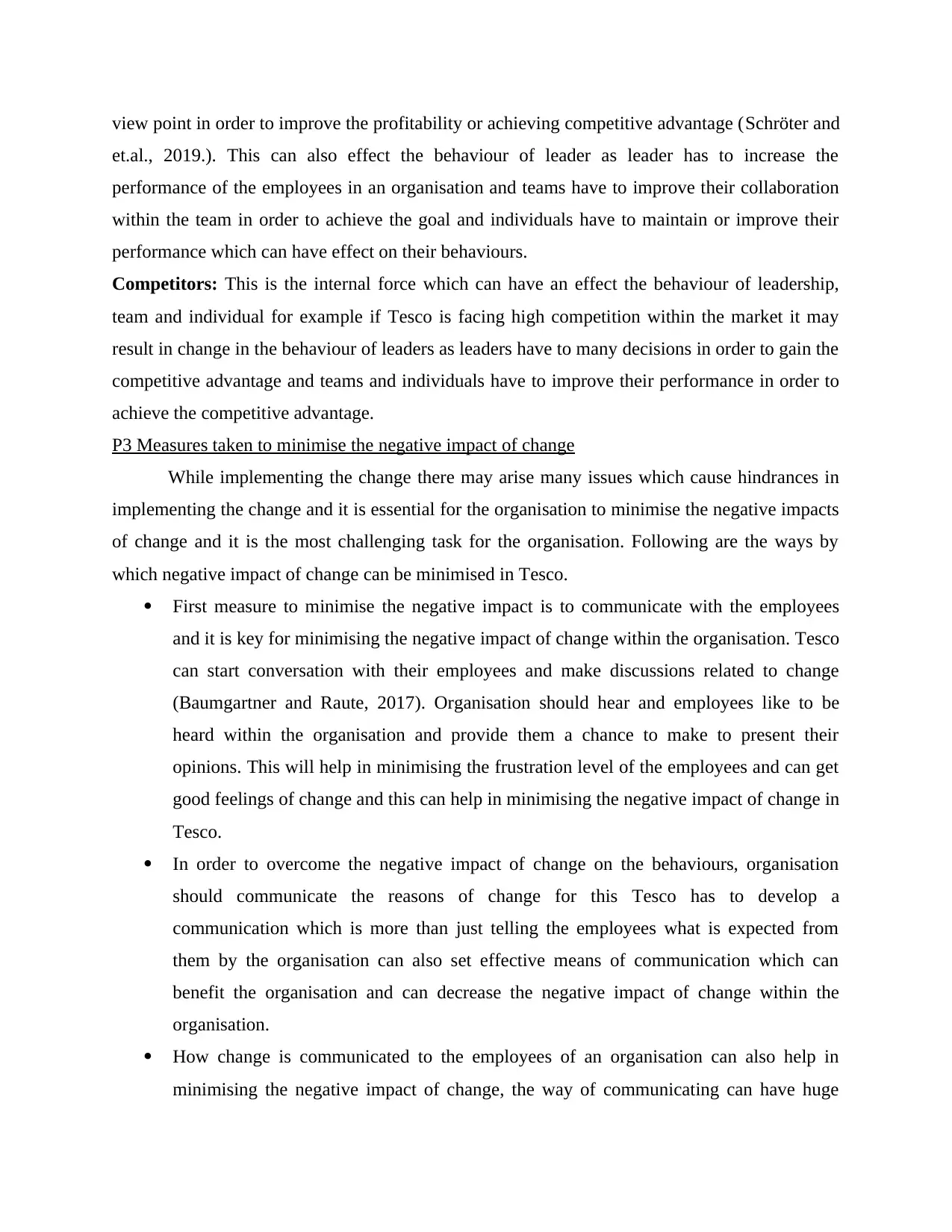
view point in order to improve the profitability or achieving competitive advantage (Schröter and
et.al., 2019.). This can also effect the behaviour of leader as leader has to increase the
performance of the employees in an organisation and teams have to improve their collaboration
within the team in order to achieve the goal and individuals have to maintain or improve their
performance which can have effect on their behaviours.
Competitors: This is the internal force which can have an effect the behaviour of leadership,
team and individual for example if Tesco is facing high competition within the market it may
result in change in the behaviour of leaders as leaders have to many decisions in order to gain the
competitive advantage and teams and individuals have to improve their performance in order to
achieve the competitive advantage.
P3 Measures taken to minimise the negative impact of change
While implementing the change there may arise many issues which cause hindrances in
implementing the change and it is essential for the organisation to minimise the negative impacts
of change and it is the most challenging task for the organisation. Following are the ways by
which negative impact of change can be minimised in Tesco.
First measure to minimise the negative impact is to communicate with the employees
and it is key for minimising the negative impact of change within the organisation. Tesco
can start conversation with their employees and make discussions related to change
(Baumgartner and Raute, 2017). Organisation should hear and employees like to be
heard within the organisation and provide them a chance to make to present their
opinions. This will help in minimising the frustration level of the employees and can get
good feelings of change and this can help in minimising the negative impact of change in
Tesco.
In order to overcome the negative impact of change on the behaviours, organisation
should communicate the reasons of change for this Tesco has to develop a
communication which is more than just telling the employees what is expected from
them by the organisation can also set effective means of communication which can
benefit the organisation and can decrease the negative impact of change within the
organisation.
How change is communicated to the employees of an organisation can also help in
minimising the negative impact of change, the way of communicating can have huge
et.al., 2019.). This can also effect the behaviour of leader as leader has to increase the
performance of the employees in an organisation and teams have to improve their collaboration
within the team in order to achieve the goal and individuals have to maintain or improve their
performance which can have effect on their behaviours.
Competitors: This is the internal force which can have an effect the behaviour of leadership,
team and individual for example if Tesco is facing high competition within the market it may
result in change in the behaviour of leaders as leaders have to many decisions in order to gain the
competitive advantage and teams and individuals have to improve their performance in order to
achieve the competitive advantage.
P3 Measures taken to minimise the negative impact of change
While implementing the change there may arise many issues which cause hindrances in
implementing the change and it is essential for the organisation to minimise the negative impacts
of change and it is the most challenging task for the organisation. Following are the ways by
which negative impact of change can be minimised in Tesco.
First measure to minimise the negative impact is to communicate with the employees
and it is key for minimising the negative impact of change within the organisation. Tesco
can start conversation with their employees and make discussions related to change
(Baumgartner and Raute, 2017). Organisation should hear and employees like to be
heard within the organisation and provide them a chance to make to present their
opinions. This will help in minimising the frustration level of the employees and can get
good feelings of change and this can help in minimising the negative impact of change in
Tesco.
In order to overcome the negative impact of change on the behaviours, organisation
should communicate the reasons of change for this Tesco has to develop a
communication which is more than just telling the employees what is expected from
them by the organisation can also set effective means of communication which can
benefit the organisation and can decrease the negative impact of change within the
organisation.
How change is communicated to the employees of an organisation can also help in
minimising the negative impact of change, the way of communicating can have huge
Paraphrase This Document
Need a fresh take? Get an instant paraphrase of this document with our AI Paraphraser
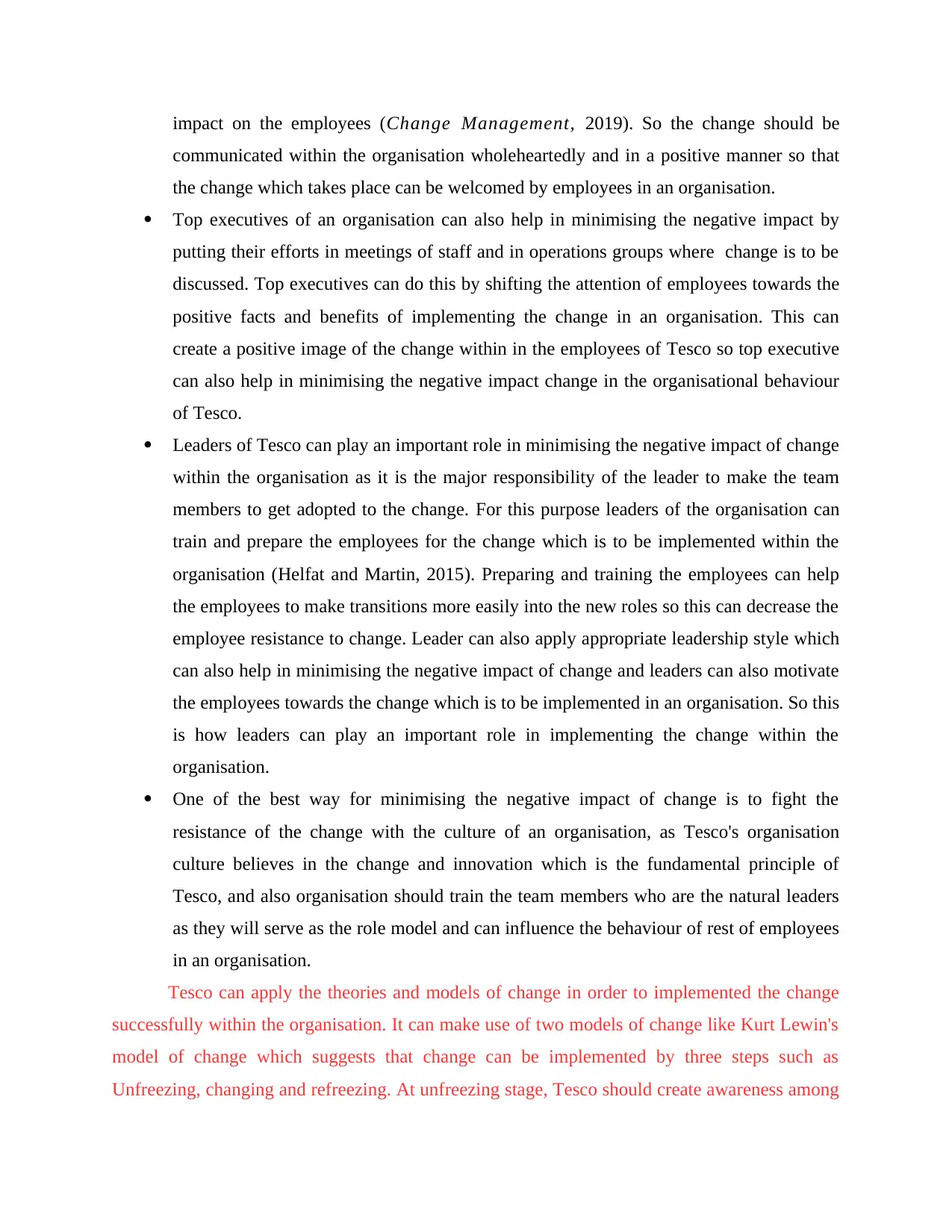
impact on the employees (Change Management, 2019). So the change should be
communicated within the organisation wholeheartedly and in a positive manner so that
the change which takes place can be welcomed by employees in an organisation.
Top executives of an organisation can also help in minimising the negative impact by
putting their efforts in meetings of staff and in operations groups where change is to be
discussed. Top executives can do this by shifting the attention of employees towards the
positive facts and benefits of implementing the change in an organisation. This can
create a positive image of the change within in the employees of Tesco so top executive
can also help in minimising the negative impact change in the organisational behaviour
of Tesco.
Leaders of Tesco can play an important role in minimising the negative impact of change
within the organisation as it is the major responsibility of the leader to make the team
members to get adopted to the change. For this purpose leaders of the organisation can
train and prepare the employees for the change which is to be implemented within the
organisation (Helfat and Martin, 2015). Preparing and training the employees can help
the employees to make transitions more easily into the new roles so this can decrease the
employee resistance to change. Leader can also apply appropriate leadership style which
can also help in minimising the negative impact of change and leaders can also motivate
the employees towards the change which is to be implemented in an organisation. So this
is how leaders can play an important role in implementing the change within the
organisation.
One of the best way for minimising the negative impact of change is to fight the
resistance of the change with the culture of an organisation, as Tesco's organisation
culture believes in the change and innovation which is the fundamental principle of
Tesco, and also organisation should train the team members who are the natural leaders
as they will serve as the role model and can influence the behaviour of rest of employees
in an organisation.
Tesco can apply the theories and models of change in order to implemented the change
successfully within the organisation. It can make use of two models of change like Kurt Lewin's
model of change which suggests that change can be implemented by three steps such as
Unfreezing, changing and refreezing. At unfreezing stage, Tesco should create awareness among
communicated within the organisation wholeheartedly and in a positive manner so that
the change which takes place can be welcomed by employees in an organisation.
Top executives of an organisation can also help in minimising the negative impact by
putting their efforts in meetings of staff and in operations groups where change is to be
discussed. Top executives can do this by shifting the attention of employees towards the
positive facts and benefits of implementing the change in an organisation. This can
create a positive image of the change within in the employees of Tesco so top executive
can also help in minimising the negative impact change in the organisational behaviour
of Tesco.
Leaders of Tesco can play an important role in minimising the negative impact of change
within the organisation as it is the major responsibility of the leader to make the team
members to get adopted to the change. For this purpose leaders of the organisation can
train and prepare the employees for the change which is to be implemented within the
organisation (Helfat and Martin, 2015). Preparing and training the employees can help
the employees to make transitions more easily into the new roles so this can decrease the
employee resistance to change. Leader can also apply appropriate leadership style which
can also help in minimising the negative impact of change and leaders can also motivate
the employees towards the change which is to be implemented in an organisation. So this
is how leaders can play an important role in implementing the change within the
organisation.
One of the best way for minimising the negative impact of change is to fight the
resistance of the change with the culture of an organisation, as Tesco's organisation
culture believes in the change and innovation which is the fundamental principle of
Tesco, and also organisation should train the team members who are the natural leaders
as they will serve as the role model and can influence the behaviour of rest of employees
in an organisation.
Tesco can apply the theories and models of change in order to implemented the change
successfully within the organisation. It can make use of two models of change like Kurt Lewin's
model of change which suggests that change can be implemented by three steps such as
Unfreezing, changing and refreezing. At unfreezing stage, Tesco should create awareness among
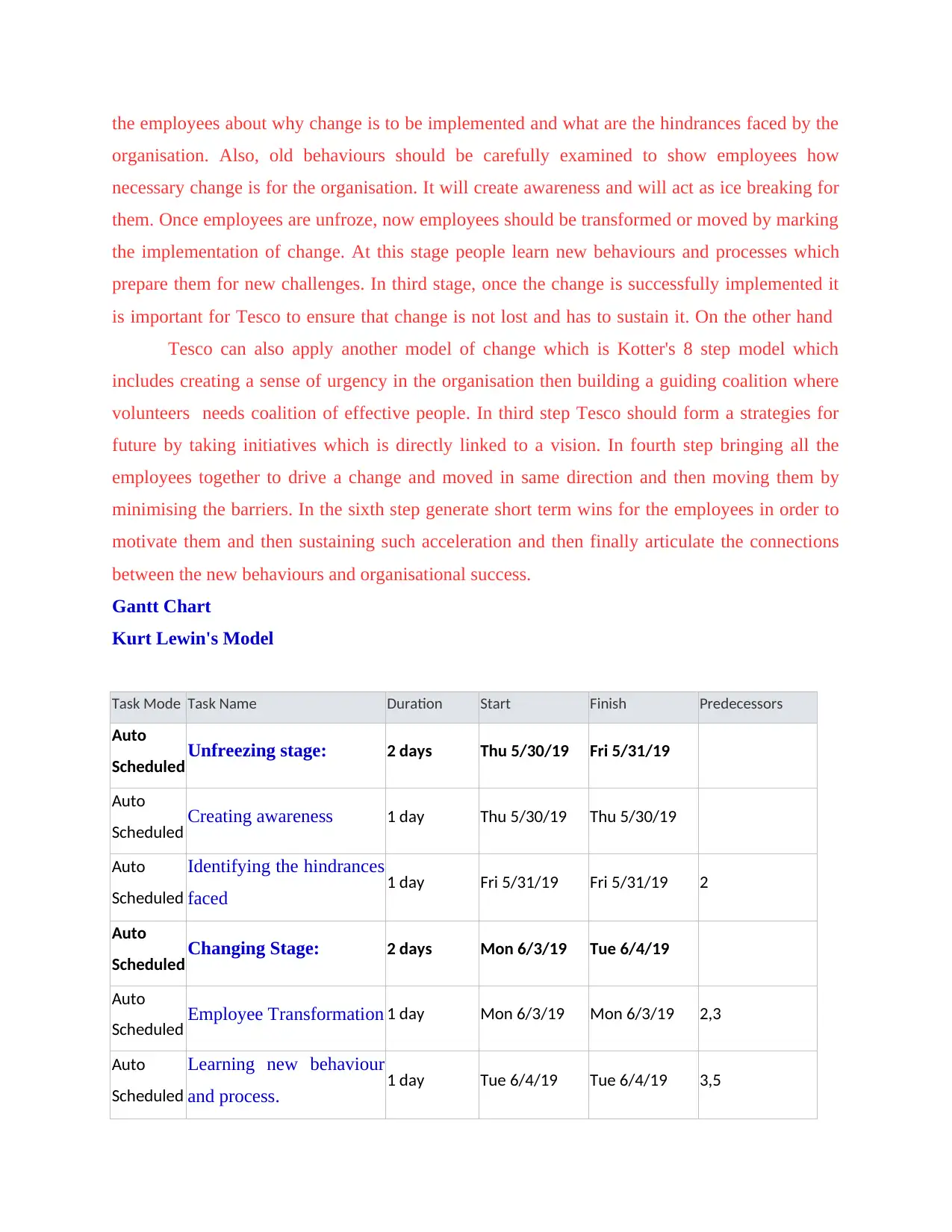
the employees about why change is to be implemented and what are the hindrances faced by the
organisation. Also, old behaviours should be carefully examined to show employees how
necessary change is for the organisation. It will create awareness and will act as ice breaking for
them. Once employees are unfroze, now employees should be transformed or moved by marking
the implementation of change. At this stage people learn new behaviours and processes which
prepare them for new challenges. In third stage, once the change is successfully implemented it
is important for Tesco to ensure that change is not lost and has to sustain it. On the other hand
Tesco can also apply another model of change which is Kotter's 8 step model which
includes creating a sense of urgency in the organisation then building a guiding coalition where
volunteers needs coalition of effective people. In third step Tesco should form a strategies for
future by taking initiatives which is directly linked to a vision. In fourth step bringing all the
employees together to drive a change and moved in same direction and then moving them by
minimising the barriers. In the sixth step generate short term wins for the employees in order to
motivate them and then sustaining such acceleration and then finally articulate the connections
between the new behaviours and organisational success.
Gantt Chart
Kurt Lewin's Model
Task Mode Task Name Duration Start Finish Predecessors
Auto
Scheduled Unfreezing stage: 2 days Thu 5/30/19 Fri 5/31/19
Auto
Scheduled Creating awareness 1 day Thu 5/30/19 Thu 5/30/19
Auto
Scheduled
Identifying the hindrances
faced 1 day Fri 5/31/19 Fri 5/31/19 2
Auto
Scheduled Changing Stage: 2 days Mon 6/3/19 Tue 6/4/19
Auto
Scheduled Employee Transformation 1 day Mon 6/3/19 Mon 6/3/19 2,3
Auto
Scheduled
Learning new behaviour
and process. 1 day Tue 6/4/19 Tue 6/4/19 3,5
organisation. Also, old behaviours should be carefully examined to show employees how
necessary change is for the organisation. It will create awareness and will act as ice breaking for
them. Once employees are unfroze, now employees should be transformed or moved by marking
the implementation of change. At this stage people learn new behaviours and processes which
prepare them for new challenges. In third stage, once the change is successfully implemented it
is important for Tesco to ensure that change is not lost and has to sustain it. On the other hand
Tesco can also apply another model of change which is Kotter's 8 step model which
includes creating a sense of urgency in the organisation then building a guiding coalition where
volunteers needs coalition of effective people. In third step Tesco should form a strategies for
future by taking initiatives which is directly linked to a vision. In fourth step bringing all the
employees together to drive a change and moved in same direction and then moving them by
minimising the barriers. In the sixth step generate short term wins for the employees in order to
motivate them and then sustaining such acceleration and then finally articulate the connections
between the new behaviours and organisational success.
Gantt Chart
Kurt Lewin's Model
Task Mode Task Name Duration Start Finish Predecessors
Auto
Scheduled Unfreezing stage: 2 days Thu 5/30/19 Fri 5/31/19
Auto
Scheduled Creating awareness 1 day Thu 5/30/19 Thu 5/30/19
Auto
Scheduled
Identifying the hindrances
faced 1 day Fri 5/31/19 Fri 5/31/19 2
Auto
Scheduled Changing Stage: 2 days Mon 6/3/19 Tue 6/4/19
Auto
Scheduled Employee Transformation 1 day Mon 6/3/19 Mon 6/3/19 2,3
Auto
Scheduled
Learning new behaviour
and process. 1 day Tue 6/4/19 Tue 6/4/19 3,5
⊘ This is a preview!⊘
Do you want full access?
Subscribe today to unlock all pages.

Trusted by 1+ million students worldwide
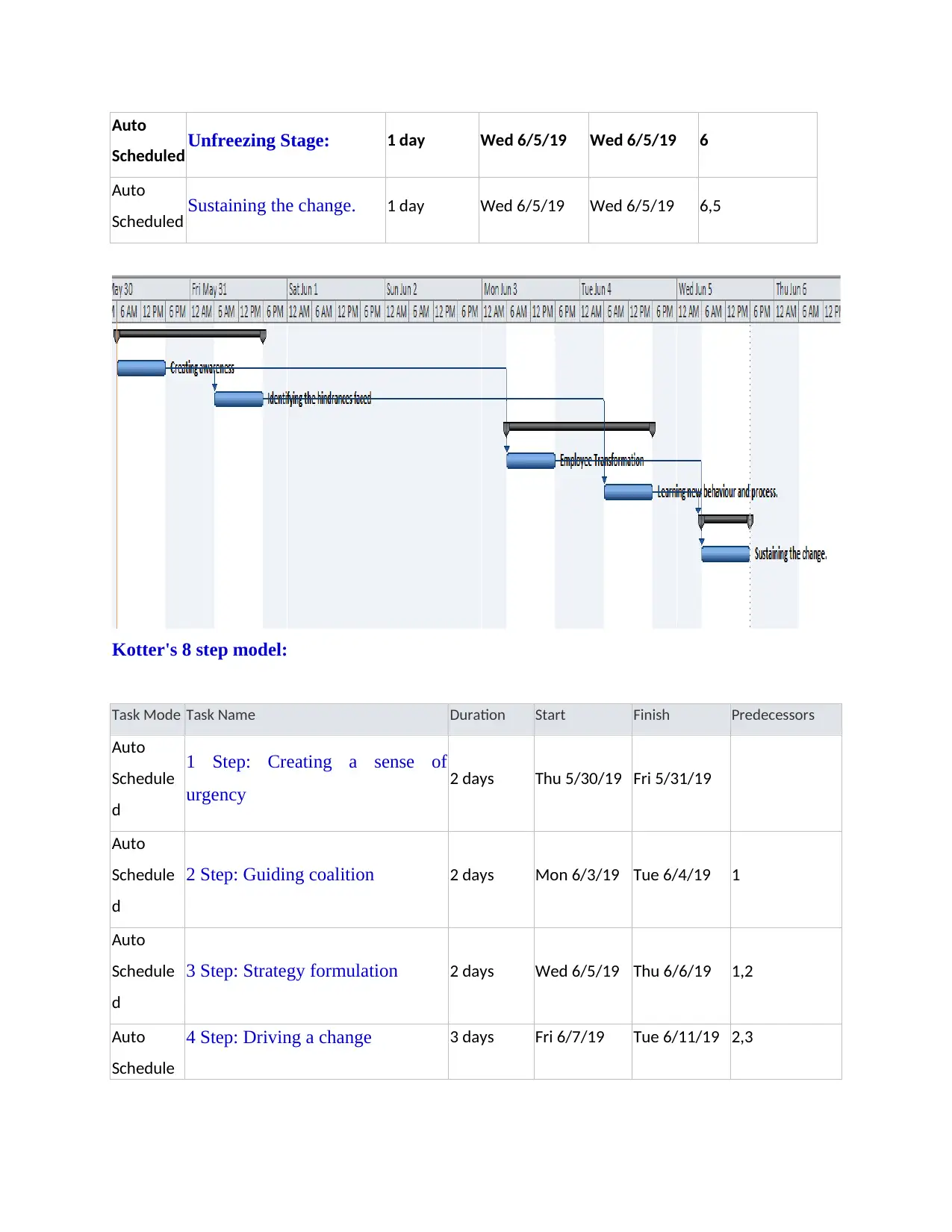
Auto
Scheduled Unfreezing Stage: 1 day Wed 6/5/19 Wed 6/5/19 6
Auto
Scheduled Sustaining the change. 1 day Wed 6/5/19 Wed 6/5/19 6,5
Kotter's 8 step model:
Task Mode Task Name Duration Start Finish Predecessors
Auto
Schedule
d
1 Step: Creating a sense of
urgency 2 days Thu 5/30/19 Fri 5/31/19
Auto
Schedule
d
2 Step: Guiding coalition 2 days Mon 6/3/19 Tue 6/4/19 1
Auto
Schedule
d
3 Step: Strategy formulation 2 days Wed 6/5/19 Thu 6/6/19 1,2
Auto
Schedule
4 Step: Driving a change 3 days Fri 6/7/19 Tue 6/11/19 2,3
Scheduled Unfreezing Stage: 1 day Wed 6/5/19 Wed 6/5/19 6
Auto
Scheduled Sustaining the change. 1 day Wed 6/5/19 Wed 6/5/19 6,5
Kotter's 8 step model:
Task Mode Task Name Duration Start Finish Predecessors
Auto
Schedule
d
1 Step: Creating a sense of
urgency 2 days Thu 5/30/19 Fri 5/31/19
Auto
Schedule
d
2 Step: Guiding coalition 2 days Mon 6/3/19 Tue 6/4/19 1
Auto
Schedule
d
3 Step: Strategy formulation 2 days Wed 6/5/19 Thu 6/6/19 1,2
Auto
Schedule
4 Step: Driving a change 3 days Fri 6/7/19 Tue 6/11/19 2,3
Paraphrase This Document
Need a fresh take? Get an instant paraphrase of this document with our AI Paraphraser
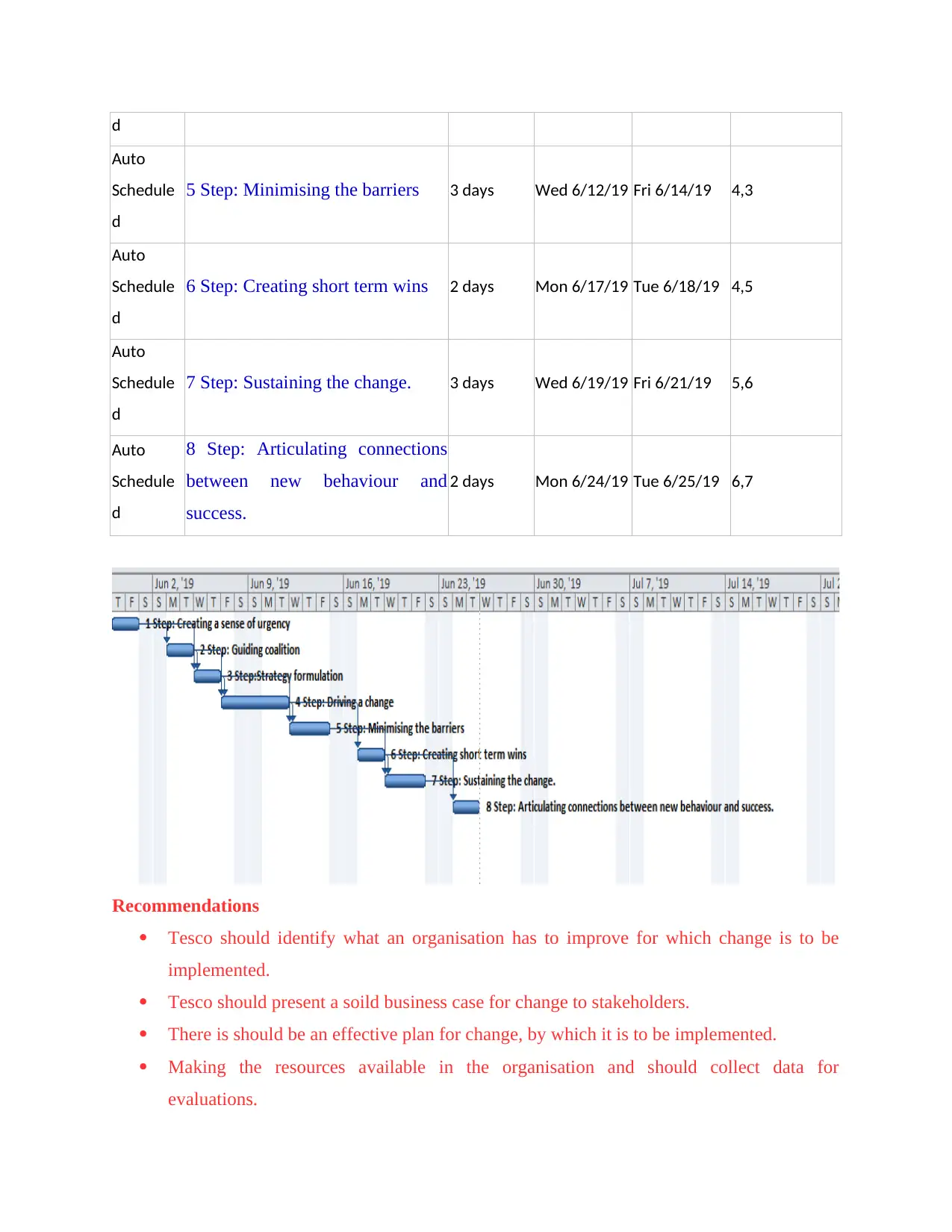
d
Auto
Schedule
d
5 Step: Minimising the barriers 3 days Wed 6/12/19 Fri 6/14/19 4,3
Auto
Schedule
d
6 Step: Creating short term wins 2 days Mon 6/17/19 Tue 6/18/19 4,5
Auto
Schedule
d
7 Step: Sustaining the change. 3 days Wed 6/19/19 Fri 6/21/19 5,6
Auto
Schedule
d
8 Step: Articulating connections
between new behaviour and
success.
2 days Mon 6/24/19 Tue 6/25/19 6,7
Recommendations
Tesco should identify what an organisation has to improve for which change is to be
implemented.
Tesco should present a soild business case for change to stakeholders.
There is should be an effective plan for change, by which it is to be implemented.
Making the resources available in the organisation and should collect data for
evaluations.
Auto
Schedule
d
5 Step: Minimising the barriers 3 days Wed 6/12/19 Fri 6/14/19 4,3
Auto
Schedule
d
6 Step: Creating short term wins 2 days Mon 6/17/19 Tue 6/18/19 4,5
Auto
Schedule
d
7 Step: Sustaining the change. 3 days Wed 6/19/19 Fri 6/21/19 5,6
Auto
Schedule
d
8 Step: Articulating connections
between new behaviour and
success.
2 days Mon 6/24/19 Tue 6/25/19 6,7
Recommendations
Tesco should identify what an organisation has to improve for which change is to be
implemented.
Tesco should present a soild business case for change to stakeholders.
There is should be an effective plan for change, by which it is to be implemented.
Making the resources available in the organisation and should collect data for
evaluations.
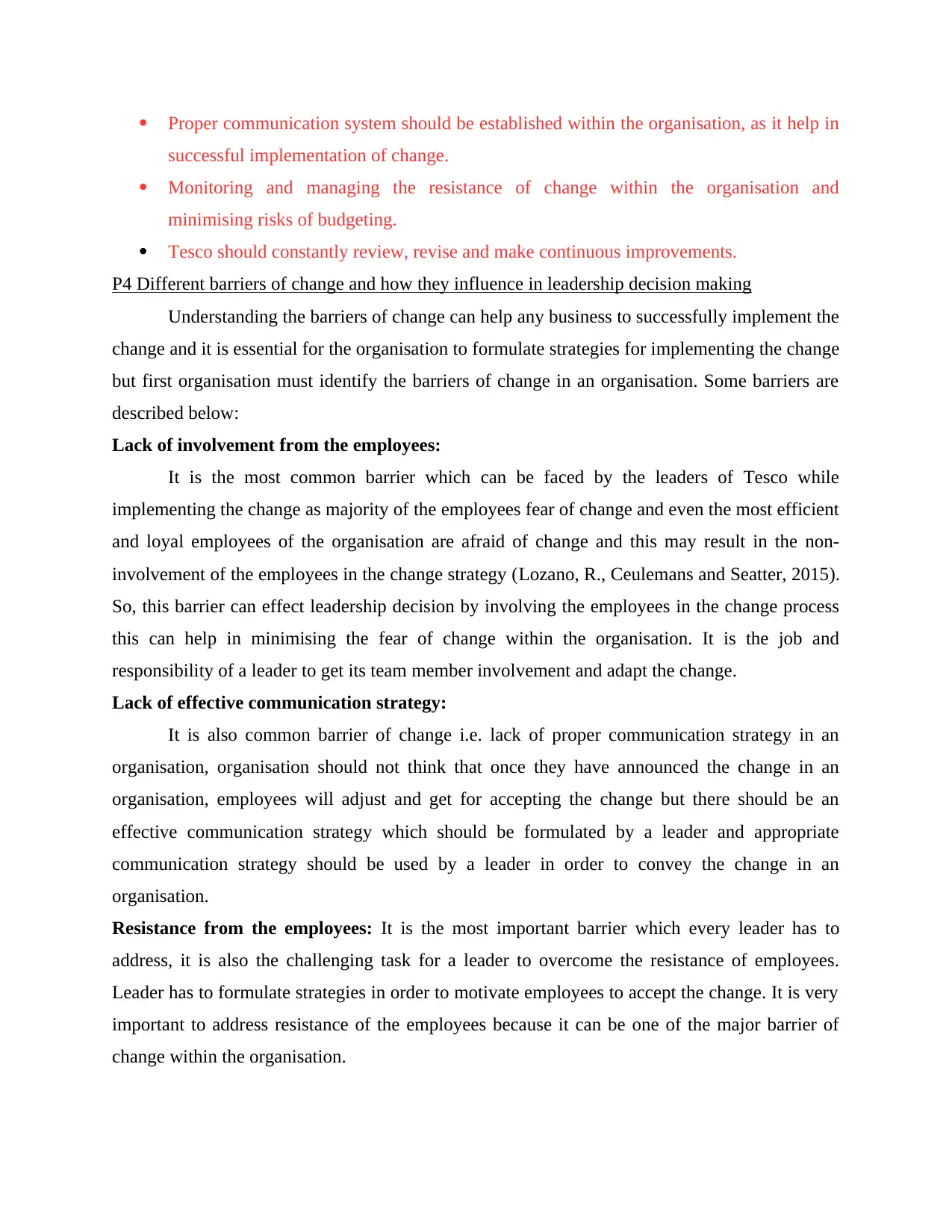
Proper communication system should be established within the organisation, as it help in
successful implementation of change.
Monitoring and managing the resistance of change within the organisation and
minimising risks of budgeting.
Tesco should constantly review, revise and make continuous improvements.
P4 Different barriers of change and how they influence in leadership decision making
Understanding the barriers of change can help any business to successfully implement the
change and it is essential for the organisation to formulate strategies for implementing the change
but first organisation must identify the barriers of change in an organisation. Some barriers are
described below:
Lack of involvement from the employees:
It is the most common barrier which can be faced by the leaders of Tesco while
implementing the change as majority of the employees fear of change and even the most efficient
and loyal employees of the organisation are afraid of change and this may result in the non-
involvement of the employees in the change strategy (Lozano, R., Ceulemans and Seatter, 2015).
So, this barrier can effect leadership decision by involving the employees in the change process
this can help in minimising the fear of change within the organisation. It is the job and
responsibility of a leader to get its team member involvement and adapt the change.
Lack of effective communication strategy:
It is also common barrier of change i.e. lack of proper communication strategy in an
organisation, organisation should not think that once they have announced the change in an
organisation, employees will adjust and get for accepting the change but there should be an
effective communication strategy which should be formulated by a leader and appropriate
communication strategy should be used by a leader in order to convey the change in an
organisation.
Resistance from the employees: It is the most important barrier which every leader has to
address, it is also the challenging task for a leader to overcome the resistance of employees.
Leader has to formulate strategies in order to motivate employees to accept the change. It is very
important to address resistance of the employees because it can be one of the major barrier of
change within the organisation.
successful implementation of change.
Monitoring and managing the resistance of change within the organisation and
minimising risks of budgeting.
Tesco should constantly review, revise and make continuous improvements.
P4 Different barriers of change and how they influence in leadership decision making
Understanding the barriers of change can help any business to successfully implement the
change and it is essential for the organisation to formulate strategies for implementing the change
but first organisation must identify the barriers of change in an organisation. Some barriers are
described below:
Lack of involvement from the employees:
It is the most common barrier which can be faced by the leaders of Tesco while
implementing the change as majority of the employees fear of change and even the most efficient
and loyal employees of the organisation are afraid of change and this may result in the non-
involvement of the employees in the change strategy (Lozano, R., Ceulemans and Seatter, 2015).
So, this barrier can effect leadership decision by involving the employees in the change process
this can help in minimising the fear of change within the organisation. It is the job and
responsibility of a leader to get its team member involvement and adapt the change.
Lack of effective communication strategy:
It is also common barrier of change i.e. lack of proper communication strategy in an
organisation, organisation should not think that once they have announced the change in an
organisation, employees will adjust and get for accepting the change but there should be an
effective communication strategy which should be formulated by a leader and appropriate
communication strategy should be used by a leader in order to convey the change in an
organisation.
Resistance from the employees: It is the most important barrier which every leader has to
address, it is also the challenging task for a leader to overcome the resistance of employees.
Leader has to formulate strategies in order to motivate employees to accept the change. It is very
important to address resistance of the employees because it can be one of the major barrier of
change within the organisation.
⊘ This is a preview!⊘
Do you want full access?
Subscribe today to unlock all pages.

Trusted by 1+ million students worldwide
1 out of 17
Related Documents
Your All-in-One AI-Powered Toolkit for Academic Success.
+13062052269
info@desklib.com
Available 24*7 on WhatsApp / Email
![[object Object]](/_next/static/media/star-bottom.7253800d.svg)
Unlock your academic potential
Copyright © 2020–2025 A2Z Services. All Rights Reserved. Developed and managed by ZUCOL.





